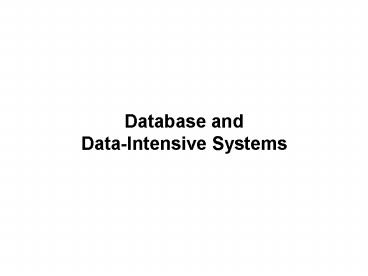Database and Data-Intensive Systems - PowerPoint PPT Presentation
Title:
Database and Data-Intensive Systems
Description:
Title: Center for Data-intensive Systems Author: csj Last modified by: ira Created Date: 12/18/2006 2:28:14 PM Document presentation format: On-screen Show (4:3) – PowerPoint PPT presentation
Number of Views:51
Avg rating:3.0/5.0
Title: Database and Data-Intensive Systems
1
Database andData-Intensive Systems
2
Data-Intensive Systems
- From monolithic architectures to diverse systems
- Dedicated/specialized systems, column stores
- Data centers, web architectures, distributed
architectures - From business data to all data
- Streaming and sensor data, semi-structured and
unstructured data - Multidimensional data, temporal data,
spatio-temporal data - Examples
- Clustering of high-dimensional data
- Tracking and continuous queries for moving
objects - Mobile service infrastructure
- Location privacy
- Spatio-textural search/hyper-local web search
- Multimedia similarity search
- This is where much of our research lives.
3
Staff
- Ira Assent, associate professor
- Christian S. Jensen, professor
- Vaida Ceikute, Ph.D. student
- Xiaohui Li, visiting Ph.D. student
- NN, Ph.D. student
- GEOCROWD indoor positioning and services
infrastructure - NN, Ph.D. student
- GEOCROWD spatial web objects
- NN, Ph.D. student
- eData Anomaly Detection in e-Science
- NN, Ph.D. student
- Streamspin
- NN, Ph.D. student
- WallViz
- NN, Ph.D. student
- REDUCTION
- NN, Ph.D. student
- REDUCTION
4
Graduate Course Portfolio dDO
- Data management for moving objects (Q3)
- The course covers selected research advances in
the general area of indexing and update and query
processing for moving objects. - Moving object tracking
- Specific indexing techniques
- R-tree based indexing
- B-tree based indexing
- Techniques for the efficient handling of frequent
updates - Techniques for range and k nearest neighbor query
processing, including one-time as well as
continuous queries
5
Graduate Course Portfolio MDDB
- Multidimensional databases (Q4)
- Selected techniques for the management of
multidimensionally represented data - Multidimensional data and applications
- Data warehouses and data mining
- Similarity search and query processing
- Efficient handling indexing and associated query
processing - Multistep similarity search
- Indexing multidimensional data
- Skyline query processing
- Data mining techniques
- Subspace clustering
- Classification
- Outlier detection
6
Graduate Course Portfolio Index
- Indexing of disk-based data (Q1)
- Indexing techniques for disk-based data for
different types of data, as well as their support
for queries and updates - General overview over indexes and query
processing - Spatial indexing structures
- Space partitioning indexing structures
- Indexes for high dimensional data
- Metric approaches
- Special techniques for complex data types
- Coming up for the first time this fall
7
Graduate Course Portfolio dDB2
- Database management systems (Q2)
- The course aims to give the participants a solid
conceptual foundation for making competent use of
a database management system. - Logical and physical query optimization and query
processing - Concurrency control techniques
- Database tuning
- Central concepts and techniques in relation to
supporting temporal and multi-dimensional data - Coming up for the first time this fall
8
Projects
- Streamspin
- Enable sites that are for mobile services what
YouTube is for video - Easy mobile service creation and sharing
- Advanced spatial and social context functionality
- Be an open, extensible, and scalable service
delivery infrastructure - MOVE
- Knowledge extraction from massive data about
moving objects - Cross-cutting activities, showcases, and
evaluation - Representation of movement data and
spatio-temporal databases - Analysis of movement and spatio-temporal data
mining - WallViz
- Collaborative analysis, joint decision making on
wall-sized displays - scale to massive data collections
- support ad-hoc queries
- automatically provide entry points for analysis
http//www.move-cost.info
8
9
Projects (2)
- GEOCROWD
- Creating a Geospatial Knowledge World
- advance the state-of-the-art in collecting,
storing, analyzing, processing, reconciling, and
publishing user-generated geospatial information
on the Web - REDUCTION
- Reducing the environmental footprint of fleets of
vehicles - Optimizing the behavior of drivers
- Supporting eco-routing of vehicles
- Enabling transparency in multi-modal
transportation - eData
- Robust analysis in the context of imperfect data
in e-Science - Detect and correct anomalies effectively
- on-line, interactive, lineage-preserving, and
semi-automatic - Scalable algorithms
10
How We Typically Work
- We target some real problem that we find
interesting. - We define the problem precisely.
- We develop a solution that is typically a data
structure or an algorithm, i.e., a concrete
technique. - To evaluate, we build prototypes.
- These are built for the purpose of studying the
properties of our solutions. - We are often interested in performance, e.g.,
runtime, space usage, communication cost. - For some solutions we state formal properties
that we then prove, e.g., the correctness of a
particular technique - Brief isolate and define problem, construct,
then evaluate
11
Example 1 Spatial Web Querying
- Setting
- Google 90 billion queries/month, 20 billion
with local intent. - We want to integrate exact locations of websites
(for shops, bars, etc.) and users into web
querying. - Queries
- Results must match the query text and must be
near the user. - Results of continuous queries must be updated as
the user moves. - Challenges?
- Support such queries with low computation cost on
the server and - with little communication between server and
client. - Solution
- Invent an index that supports both text and
location - Use a safe zone to reduce the communication
between user and server for continuous queries
12
Example 2 Fraud detection
- There are billions of financial transactions per
minute - How do we uncover fraud?
- Scalability
- In-time for reaction
- Manageable results
- Possible solution sketch
- Identify attributes of suspicious transactions
- Sort incoming transactions into a tree-structure
of historic data - When processing time is up, output degree of
suspicion based on similarity to valid or
fraudulent historic data
13
Interested?
- Come talk to us!
- We currently have M.Sc. and PhD. thesis openings































